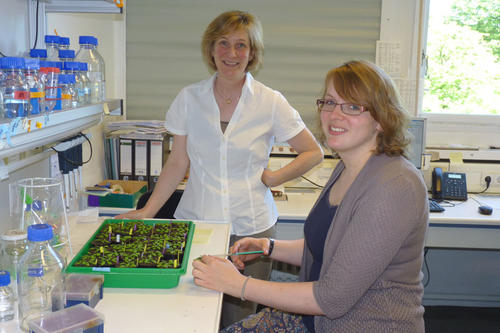A Signal Chain from Cell to Cell
Biochemist Tina Romeis of Freie Universität Berlin has decoded the mechanisms used to transmit stimuli in plants.
Aug 26, 2013
Professor Tina Romeis and doctoral student Heike Seybold have deciphered the mechanisms involved in the transmission of stimuli in plants.
Image Credit: Bianca Schröder
How plants transmit stimuli is an area where research has been lacking so far. With its research findings, the working group has made great strides toward explaining signal transport. Transmission of stimuli is highly important in terms of a plant’s defensive responses to pests. For growers, research on plants’ immune responses is important because they can develop varieties with greater resistance through intelligent breeding practices. This could help reduce the use of pesticides.
Shifting from a Resting State to a Defensive One – and Then?
For their experiments, the researchers at the Dahlem Centre of Plant Sciences at Freie Universität exposed mousear cress – a model organism for plant researchers – to a bacterial attack and studied the changes in a leaf far removed from the attack site 15 minutes later. “Our goal was to explain what happens when a plant shifts from a resting state to a defensive one within a few minutes,” Romeis explains. The team succeeded in creating a model of a self-perpetuating signal.
The signal chain proceeds as follows: Stresses – like a confrontation with a bacterium – activate the enzyme CPK5 within the plant. This enzyme transmits phosphate residues, changing a protein that, in turn, initiates the formation of “reactive” oxygen species (ROS) – corrosive forms of oxygen, such as hydrogen peroxide. These types of oxygen are toxic to many microorganisms, but they also play a role in transmitting signals. The researchers were able to show that the hydrogen peroxide, which can move freely from cell to cell, also activates the CPK5 enzyme. “So via reactive oxygen species, the signal goes from the starting point of the original bacterial attack to more distant cells, with the enzyme being activated over and over,” Romeis says.
Proof of the Cell-to-Cell Mechanism
Cell-to-cell transmission was postulated by American researchers back in 2009, after plant researchers had previously pursued other theories. “For a long time, people thought that plant defensive signals were predominantly transported through the plants’ vascular tissue, but they couldn’t prove it,” Romeis explains. The cell-to-cell mechanism mediated by reactive oxygen species, she says, is a much more efficient defense mechanism than transportation via the vascular tissue, since it means all of the cells in all parts of the plant can be reached quickly.
In its experiments, the research group used mass spectrometry to analyze the protein that causes reactive oxygen species to form, causing the rapid transmission of signals. In mass spectrometry, a protein is broken down into individual fragments, which are then used to determine its mass. If the target protein has received the information on the bacterial infection and engages its defenses, it attaches an additional phosphate, which makes it heavier. “Through mass spectrometry, we were able to show that the target protein in the plant gets heavier within just a few minutes, even in distant plant tissue,” Romeis says. “That means the signal has been transmitted.”
This use of mass spectrometry is new in plant research, Romeis explains. Plants that lack the CPK5 enzyme were unable to add phosphate to the target protein, so they could not activate it. This also meant that no signals were transmitted to leaf cells farther away – evidence that CPK5 plays a key role in signal transportation.
Further Information
Prof. Dr. Tina Romeis, Fachbereich Biologie, Chemie, Pharmazie / Institut für Biologie, Tel. + 49 30 838 - 53123, E-Mail: tina.romeis@fu-berlin.de

